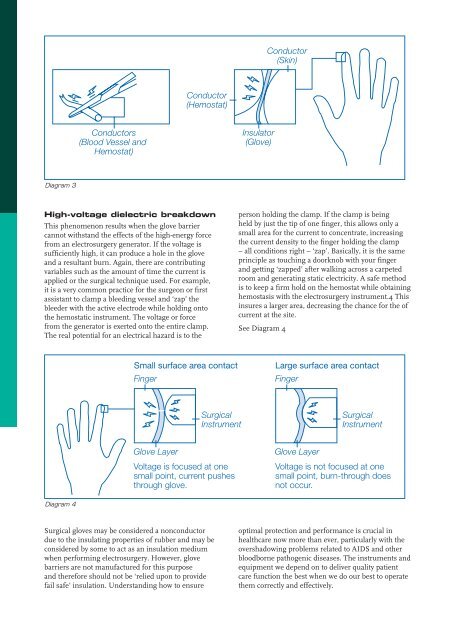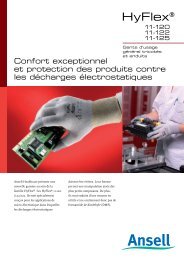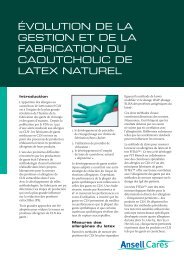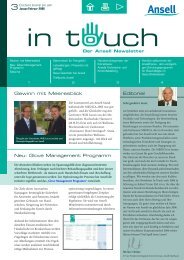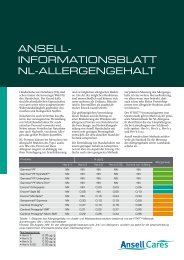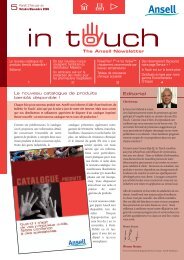Electrosurgery and Latex Gloves - Ansell Healthcare Europe
Electrosurgery and Latex Gloves - Ansell Healthcare Europe
Electrosurgery and Latex Gloves - Ansell Healthcare Europe
Create successful ePaper yourself
Turn your PDF publications into a flip-book with our unique Google optimized e-Paper software.
Diagram 3<br />
High-voltage dielectric breakdown<br />
This phenomenon results when the glove barrier<br />
cannot withst<strong>and</strong> the effects of the high-energy force<br />
from an electrosurgery generator. If the voltage is<br />
sufficiently high, it can produce a hole in the glove<br />
<strong>and</strong> a resultant burn. Again, there are contributing<br />
variables such as the amount of time the current is<br />
applied or the surgical technique used. For example,<br />
it is a very common practice for the surgeon or first<br />
assistant to clamp a bleeding vessel <strong>and</strong> ‘zap’ the<br />
bleeder with the active electrode while holding onto<br />
the hemostatic instrument. The voltage or force<br />
from the generator is exerted onto the entire clamp.<br />
The real potential for an electrical hazard is to the<br />
Diagram 4<br />
Surgical gloves may be considered a nonconductor<br />
due to the insulating properties of rubber <strong>and</strong> may be<br />
considered by some to act as an insulation medium<br />
when performing electrosurgery. However, glove<br />
barriers are not manufactured for this purpose<br />
<strong>and</strong> therefore should not be ‘relied upon to provide<br />
fail safe’ insulation. Underst<strong>and</strong>ing how to ensure<br />
person holding the clamp. If the clamp is being<br />
held by just the tip of one finger, this allows only a<br />
small area for the current to concentrate, increasing<br />
the current density to the finger holding the clamp<br />
– all conditions right – ‘zap’. Basically, it is the same<br />
principle as touching a doorknob with your finger<br />
<strong>and</strong> getting ‘zapped’ after walking across a carpeted<br />
room <strong>and</strong> generating static electricity. A safe method<br />
is to keep a firm hold on the hemostat while obtaining<br />
hemostasis with the electrosurgery instrument.4 This<br />
insures a larger area, decreasing the chance for the of<br />
current at the site.<br />
See Diagram 4<br />
optimal protection <strong>and</strong> performance is crucial in<br />
healthcare now more than ever, particularly with the<br />
overshadowing problems related to AIDS <strong>and</strong> other<br />
bloodborne pathogenic diseases. The instruments <strong>and</strong><br />
equipment we depend on to deliver quality patient<br />
care function the best when we do our best to operate<br />
them correctly <strong>and</strong> effectively.


